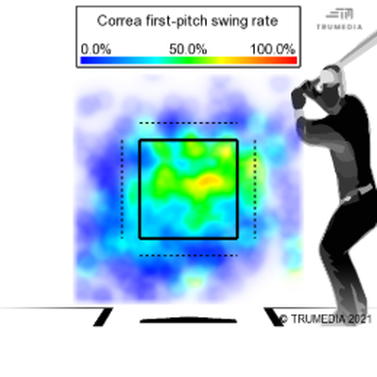
On Saturday afternoon, the Houston Astros will attempt to take a 2-0 lead over the Boston Red Sox in the best-of-seven American League Championship Series. The Astros are seeking their franchise’s fourth pennant, including their third in five years.
If the Astros are to advance to another World Series, then shortstop (and impending free agent) Carlos Correa seems certain to play a big role.
After all, it was Correa who provided Game 1’s most memorable moment (the Astros never trailed after his homer in the seventh inning), and it was Correa who led all position players in Wins Above Replacement this year, narrowly edging out Marcus Semien. Correa has proven he enjoys the big stage under the October lights, too. For his career, he’s hit .276/.350/.531 in postseason play, resulting in an OPS that’s more than 40 points superior to his career regular-season figure.
The Red Sox might be wondering in advance of Game 2: just how do we get Correa out? We’re not advanced scouts, but let’s answer nine questions about his approach.
1. Does he like to swing on the first pitch? Nope. Correa swung on just 27 percent of the first offerings he saw during the regular season, as opposed to 42 percent overall. He’s selective about what he goes after, and if you take a look at the heat map below, it’s clear that he appears to keyhole a spot in the inner half.
Two of Correa’s eight home runs on fastballs came against pitchers who, on 0-0 counts, tried to either sneak a fastball by him inside or tried to lay one in there over the middle. Beware.
2. How does his behavior change based on the first pitch? As we established, Correa is choosy about what he swings at on the first pitch. What about the second? It depends on the result of the first. When he’s ahead 1-0, his swing rate ticks up to 31 percent; when he trails 0-1, it goes all the way up to 48 percent.
3. Does his approach shift as counts get deeper? A common theme throughout Correa’s at-bats is that if he has the advantage, he becomes extremely prejudiced with his swings, and he will offer only if it’s something he can drive. It’s a sign of a confident hitter who knows his strengths and how to maximize them. The interesting thing is that Correa alters his behavior when he gets ahead in, say, a 2-1 count. Instead of remaining locked in on the inner half, he starts looking the other way, likely realizing that a pitcher is going to stay away at all costs. Relatedly, Correa was more likely to shoot a ball the opposite way in hitter’s counts than in either pitcher’s (32) or even (28) counts.
4. And with two strikes? Correa is in swing mode by that point. He offered at nearly 60 percent of the two-strike pitches he saw, and his chase rate peaked at 35 percent. Correa’s contact rate also peaked, checking in 10 percentage points higher than when he had no strikes. That may sound odd, but it’s intuitive: with no strikes, Correa is swinging only when he has a chance to send the ball to Valhalla. That means he’s going to take more aggressive swings than with two strikes, when he’s prioritizing contact to damage.
5. Is there any pitch type he struggles with? Here are Correa’s percentile ranks in a few choice statistics among batters who saw at least 100 of the pitch type this year:
|
Fastballs |
81st |
88th |
82nd |
|
Sliders |
73rd |
55th |
76th |
|
Curveballs |
62nd |
36rd |
63rd |
|
Changeups |
74th |
75th |
98th |
Not every individual pitch is the same, but if you’re going off the above table and nothing else, then pitchers with curveballs should plan on attacking Correa with it early and often. Statistically, it seems like his weakest point.
6. Have the Red Sox been successful against him? Nope. In six regular season contests against Boston this year, he hit .333/.467/.583 with four of his eight hits going for extras. Correa’s dominance against Boston has been a career-long thing, too. His 1.060 OPS against the Red Sox is his second-highest against any team, minimum 10 games. (The top spot belongs to the Colorado Rockies.)
7. Who has done a good job against him? Oakland Athletics southpaw Sean Manaea has faced Correa more than any other pitcher, seeing him 47 times and holding him to a .205/.340/.205 slash line.
8. How? Pitcher-batter matchups have sample sizes that render their results more descriptive than predictive, but for entertainment purposes only, we watched all of Manaea’s matchups with Correa in 2021. If Manaea has a formula, it’s to steal strikes with his secondary pitches early — especially his curveball — and then, when he uses his sinker (especially on the inner half) to make sure he locates it.
9. What should Eovaldi know? Come Saturday afternoon, Correa will be facing off against Nathan Eovaldi, a hard-throwing right-hander with a deep release point and a broad arsenal. If we had to give Eovaldi one piece of advice, it would be to steal a strike early with his curveball, his second-most used pitch. If Eovaldi can do that, he can get Correa into situations where he’s more likely to expand his swing radius, thereby creating the potential for whiffs and reducing the chances that Correa will again be checking his watch after launching a pivotal home run.
2021 MLB postseason gear now available
The 2021 MLB Playoffs are here. In celebration, 2021 MLB postseason gear is now available for select teams. Shop hoodies, shirts, and more here.
We may receive a commission for purchases made through these links.


